He was an engineering visionary whose work I’ve witnessed before.
Last summer, I got behind the wheel of the virtual Lotus 49 — one of the first Formula 1 cars created by legendary designer Colin Chapman.
In the latest stop on my Summer Road Trip, it was time to again see eye to eye with Chapman through another one of his greatest creations: the Lotus 79.
Those two cars may be the most celebrated achievements of the British engineer, but they couldn’t be much more different. The 49 was famous for its simplicity and overall lack of downforce, while the 79 took aerodynamics to a new level.
While the cars look like they’re from entirely different eras, it has always surprised me that the 79’s first race came only eight years after the 49’s final one. Maybe that’s just another testament to Chapman, whose ability to imagine and perfect potential designs decades before the current age of computer simulations did as much to open Formula 1’s future as it did to close up loopholes in the rulebook.
Today’s cars with their multi-element wings and sidepods might make the Lotus 79’s basic architecture look dated, but the Lotus 79 made its downforce from beneath. It’s the car most synonymous with the term “ground effects” – directing airflow through the underbody of the car to create low-pressure areas, effectively sealing it to the ground.
The Lotus 79 wasn’t the first car to use ground effects – previous attempts dated back Jim Hall’s Chaparral cars in the early 1960s – but compared to the Lotus 78 and its other predecessors, the 79’s out-of-sight design improvements also made its performance fit that superlative.
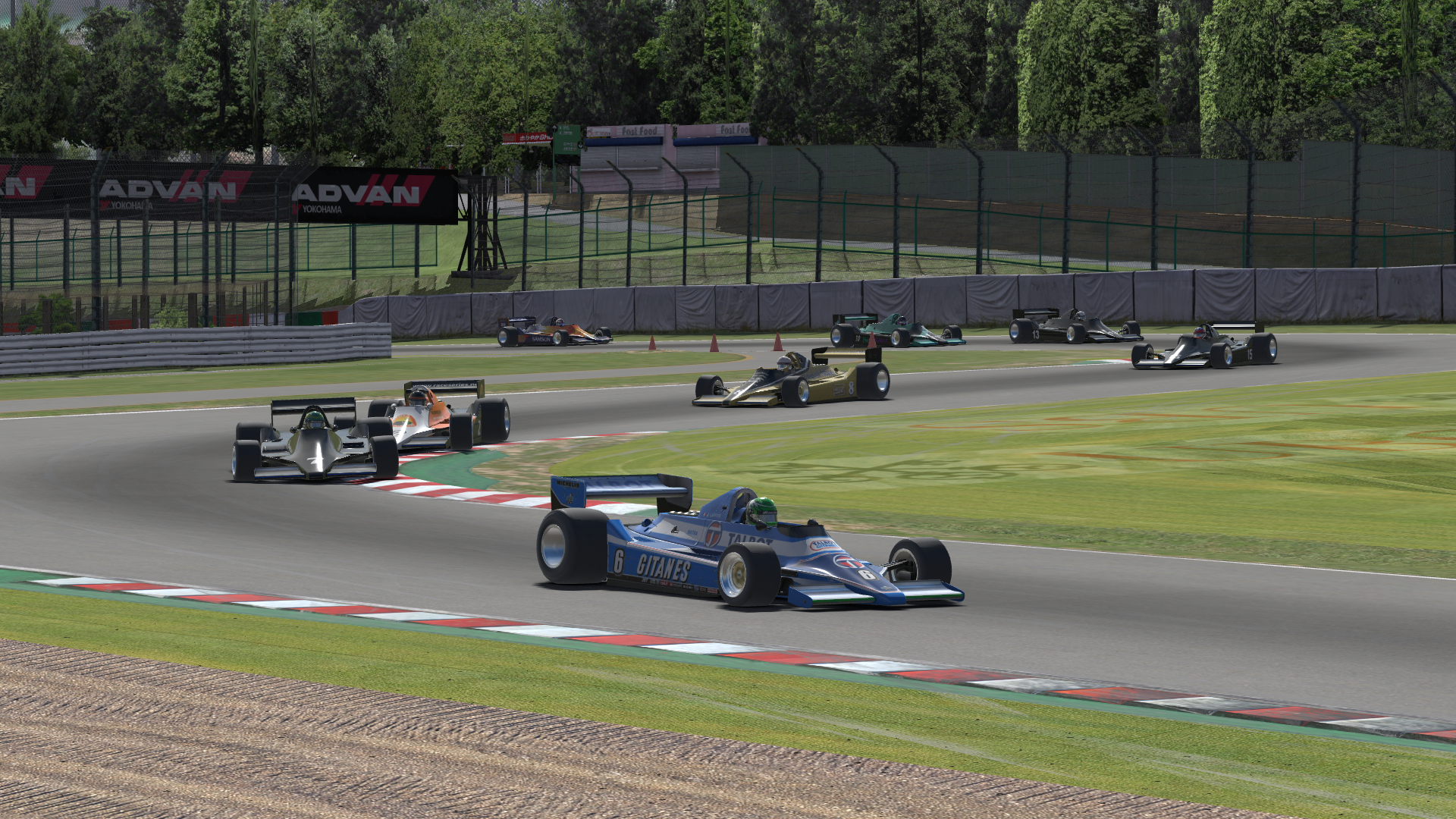
The Lotus 79 field winds through the Casio Triangle.
Thirty-one years after its real-world debut, the Lotus 79 became the first historical car in iRacing’s collection, and any sim racers getting behind the wheel found it was a beast to drive. Its cornering abilities were balanced by its raw power, and as with iRacing’s early versions of the Lotus 49, it was extremely easy to get wheelspin off the corners.
Before this week, my only attempts to race the Lotus 79 came almost six years ago at Suzuka. In my first race, I crashed out after just one lap, and in my second race, I spun twice from my fourth-place starting spot and finished a lap down in fifth.
Since then, the Lotus has been somewhat neglected by iRacing. While other older cars such as the Skip Barber Formula 2000 have received regular improvements, the Lotus 79 last received physics updates in 2016, and has had its tire model updated only twice since 2012.
However, even those changes have been enough for at least one Lotus driver to denounce the current version as a shell of its former self — “a car any average driver can drive” that’s “not half as much fun”, he proclaimed.
If you listen to the Lotus’s real-world pilots, you’ll hear that its drivability was a huge improvement over other F1 cars of the era. Mario Andretti said the Lotus 78 drove “like a London bus” compared to the 79, and Ronnie Peterson said that with a good setup in the car, all he had to do was steer.
Coming into this week and my return to Suzuka, I wasn’t sure which version to expect: the tail-happy speed demon or the stuck-to-the-road car that would drive itself.
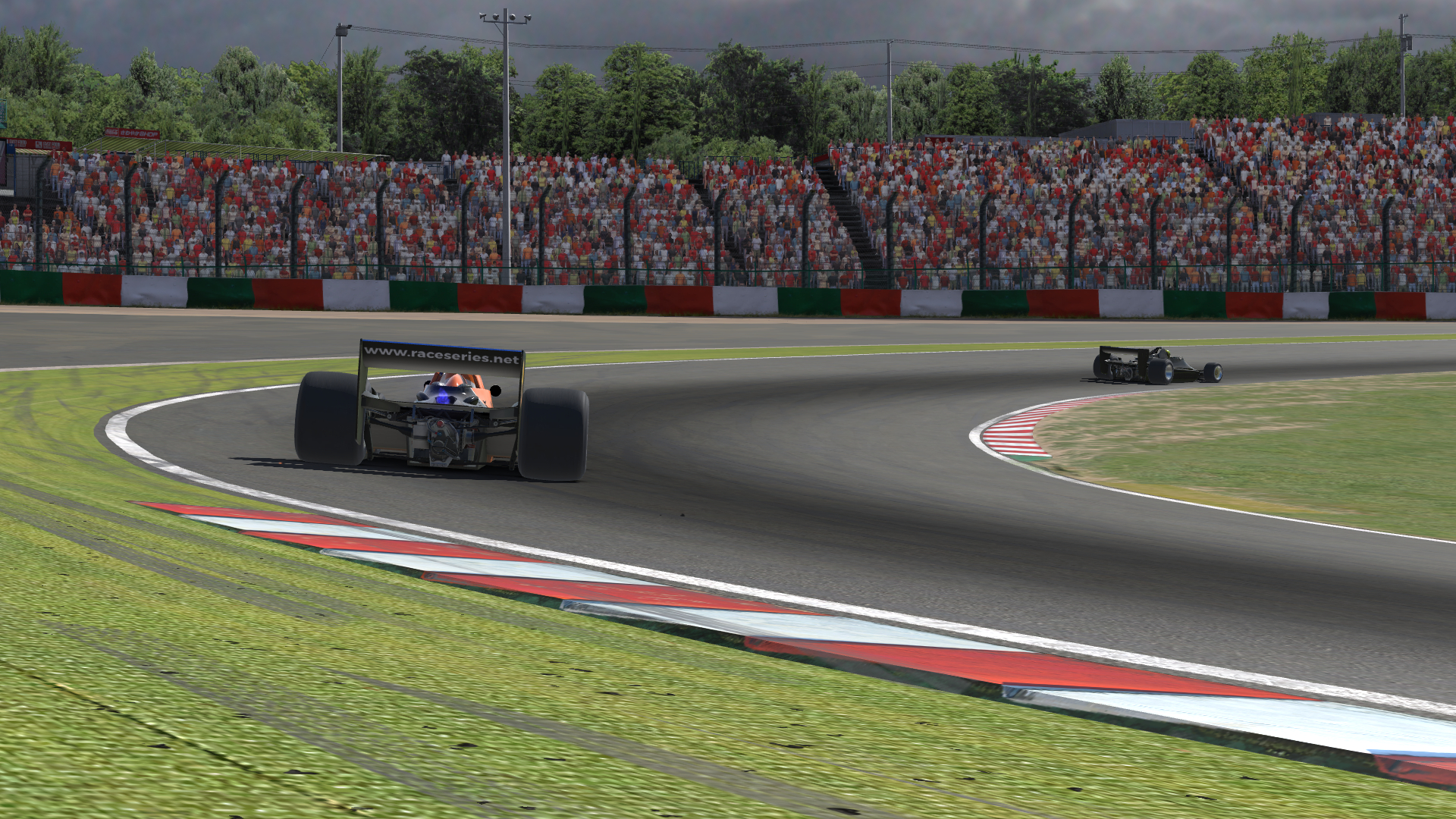
Pushing hard into Suzuka’s tricky turn 2.
Learning the Lotus
To help prepare me for whatever I might face in the Lotus, I consulted with my teammate Karl Modig. As a fellow Swede like Peterson, I hoped he might have some Lotus-driving abilities in his genes that he might be able to share.
He admitted that his recent experiences in the car have been limited – he last raced it 2016 – but to my surprise, he compared its driving characteristics to two very modern cars, including one that I drove only a week ago.
Like the LMP1 cars and the current IndyCar, the Lotus 79, Karl said, “drives like a boat in the slow corners” but has tons of downforce in faster corners with plenty of straight-line speed. Of course, the top-end prototypes make their speed using newfangled hybrid systems. The Lotus uses the raw 475 horsepower from its normally aspirated V8 engine.
Perhaps this comparison should have been obvious since in some ways, the Lotus 79 is the most similar ancestor of modern open-wheeled and prototype cars, having pioneered some of the features now commonly found on them.
Getting the most out of the ground effects was an extra challenge, Karl told me. He said that fast drivers could straddle the line between decreasing tire grip and increasing downforce, often trailbraking into corners and sliding the rear of the car to carry extra speed.
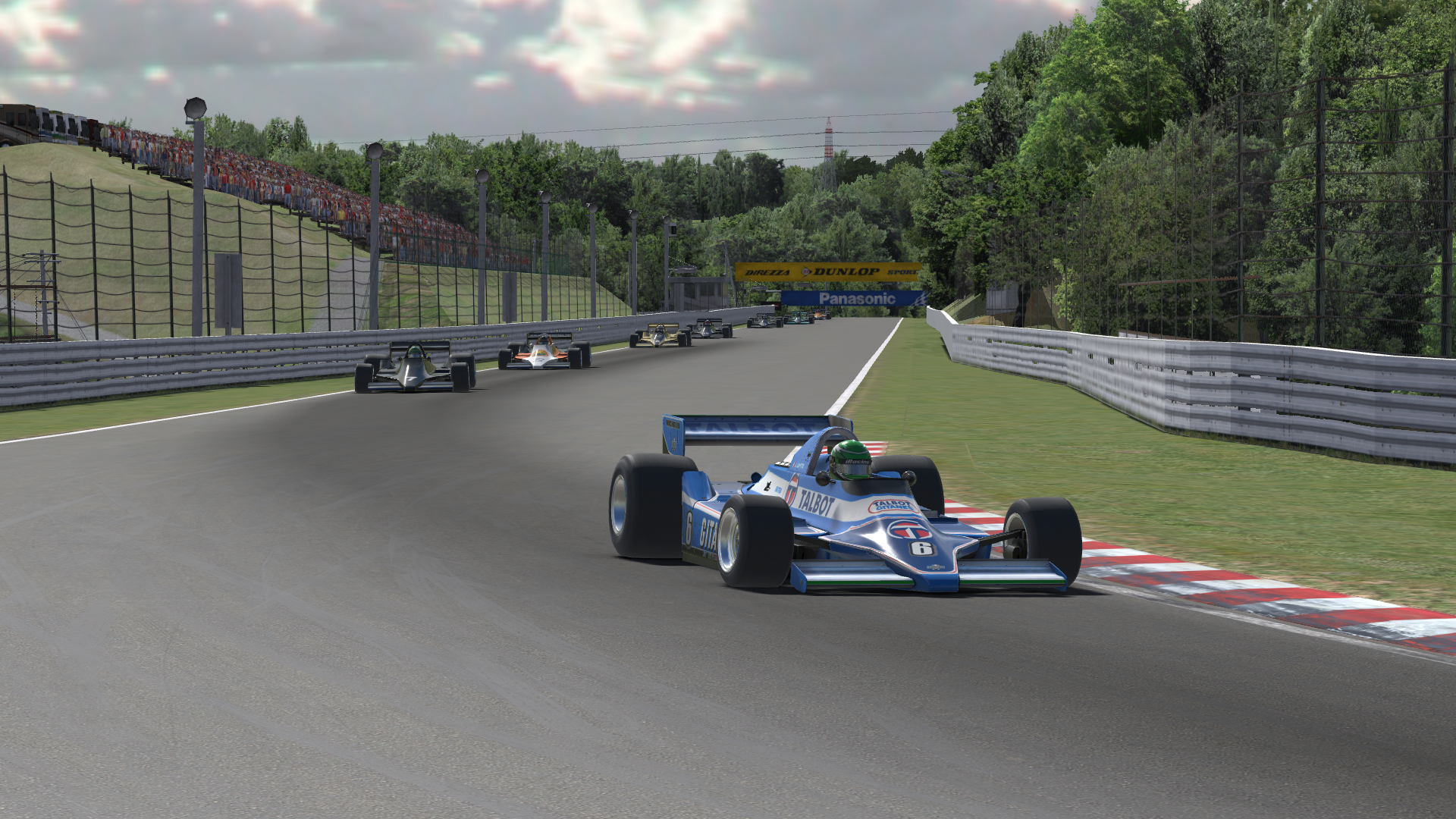
Karl leads a line of cars into the fast 130R corner.
In that sense, putting the new tire model on the Lotus would have certainly made it easier to tell when it’s sliding, which would get sim racers closer to the seat-of-the-pants sixth sense that real-world drivers can use.
However, neither Karl nor myself were experienced enough in the car to drive it that hard every lap, and we both knew the biggest key in a race wouldn’t be riding that sort of edge, but simply surviving.
So as we practiced together on Thursday afternoon, we mainly tried to find some consistency. Karl clearly had a pace advantage, and after studying the detailed telemetry – one feature that drivers of the Lotus 79 era surely wish they’d had — we discovered that I was losing time in the First Turn and Spoon Curve: both corners with high-speed entries tightening into a slower second apex.
Maybe Karl was underestimating his ability to push this car toward its limits, I thought. Perhaps there really is something special woven into that Scandinavian DNA.
After our practice together, I was more than half a second off his pace, and while I could string clean laps together, I was no closer to deciphering the speed secrets of the Lotus 79.
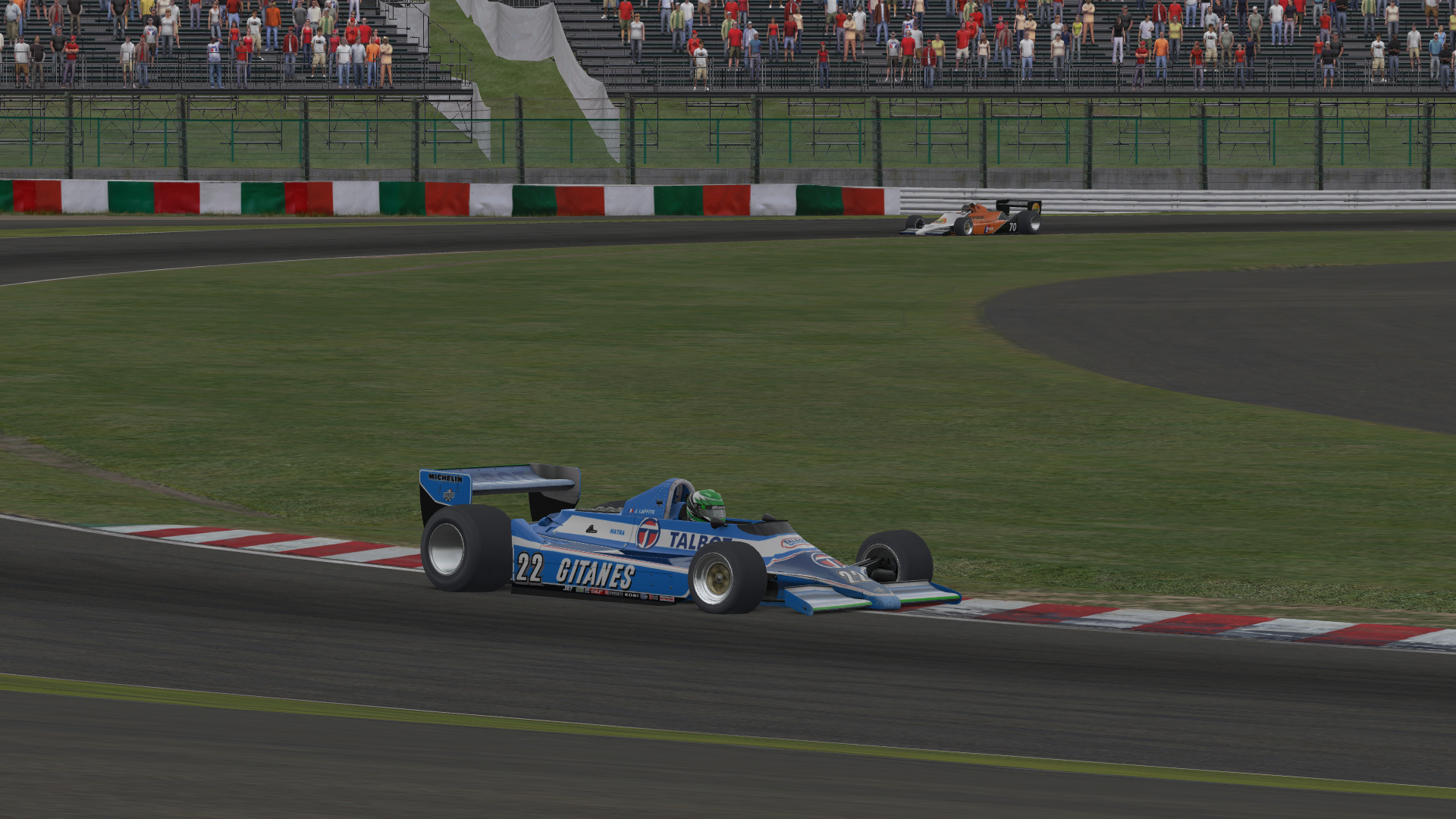
Following Karl through the Spoon Curve at Suzuka.
A New Sensation
I got back online early on Saturday morning, several hours before our planned race together, to put in some more practice. I experimented with some setup changes like adding extra wing, but also found it easy to throw off the balance of the car — the same thing I struggled with in the waning hours of practice last week in the IndyCar.
After a full race run on a fairly warm track, I felt confident about being able to complete the race distance but not particularly fast. In a car whose main claim to fame was pushing the limits of what a race car could do, I felt the need: the need for speed.
I took out fuel, increased the cambers, and bumped up the tire pressures for a mock qualifying run. And on that flying lap, I suddenly caught a glimpse of what the Lotus 79 was truly capable of.
Without a full tank of fuel, it seemed to glide through the corners as if it were on rails. Ronnie was right! And on the straightaways, I felt like I had engaged warp drive. I was lapping faster than ever before, and that increased pace was sensible as the virtual scenery flashed past my car on all sides.
Although it was a bit demoralizing to see that even my fastest lap was nearly a second off the two fastest drivers in the session, I also understood that those were drivers who clearly knew how far this car can be pushed. I could only imagine how it must feel to drive it that much closer to the limit.
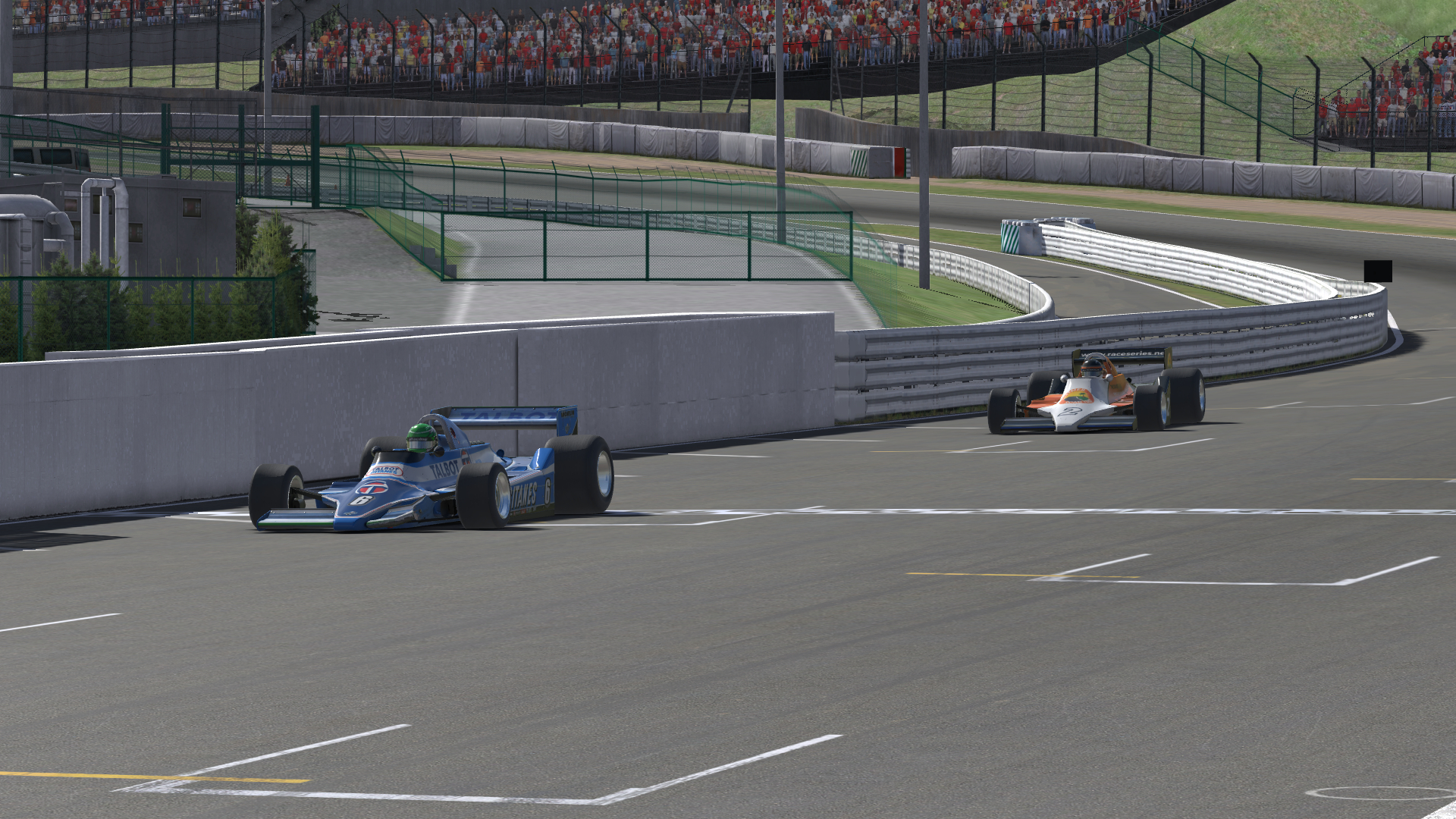
Running nose to tail with Karl down the frontstretch.
Karl joined me for a few final minutes of practice and we settled on our setup but wondered if there was more speed to be found by adding more downforce, using the wings to complement the car’s ahead-of-its-time underbody aerodynamics.
The time for second-guessing was over, though, as our race session was about to start. As with other less popular series, the Classic Lotus Grand Prix, which solely features the Lotus 79, organizes several pre-set official time slots each week to ensure at least a few races with strong, full fields. The community targets the 1430 and 1630 GMT races on Saturday and Sunday, so Karl and I picked the earlier Saturday slot for our first race together.
After studying the results of other races this season, I noticed that big gaps typically formed between cars throughout the field. A few of the fastest drivers always tended to distance themselves at the front, followed by a decent mid-pack and then some slower drivers alternately clumped together or many seconds apart.
Knowing my pace wouldn’t be good enough to challenge the frontrunners, I hoped I could fit somewhere solidly in the midfield.
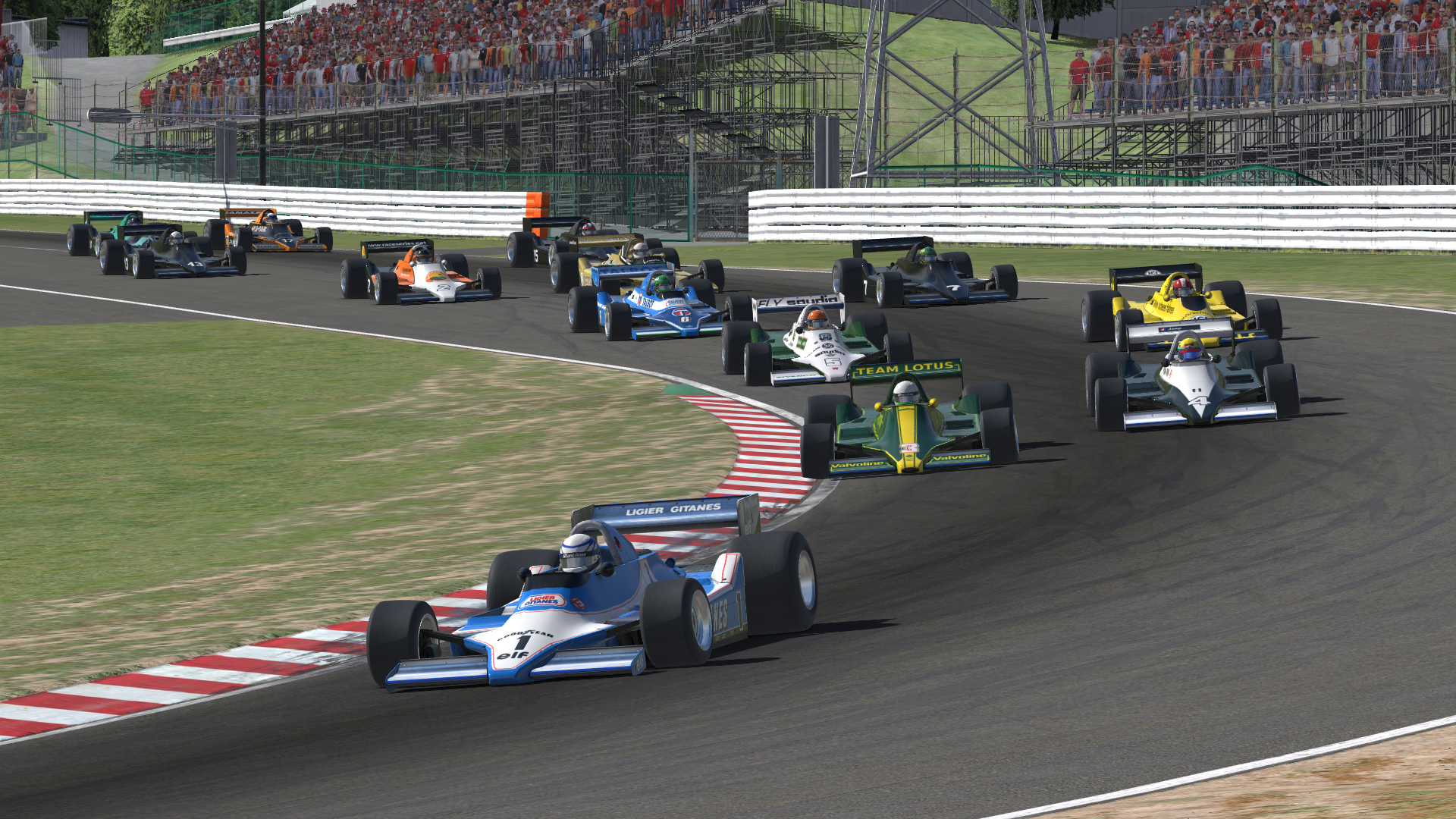
The field heads into turn 1 on the first lap.
A Steady Start
After qualifying, I realized even that might be a lofty goal. I would start in eighth place, with a half-second separating me from Karl two spots ahead on the grid and from the ninth-place driver who would line up next to me.
Karl assured me that in return to this car, the back of the mid-pack may not be a bad position to be in. If I could distance myself from the cars behind, I could just focus on staying in touch with Karl and the other cars ahead of me.
First, though, I had to get through the standing start, and my Summer Road Trip experiences with those have been rocky at best. Despite all the power of the Lotus, I managed to avoid wheelspin off the line and hold my position into turn 1.
Early in the first lap, the car behind me was clearly looking for a way past, forcing us to go two-wide through several of the snaking corners in the esses. Through the faster second half of the Suzuka circuit, I pulled ahead, and as our qualifying times suggested, I was able to gap him in the next few laps.
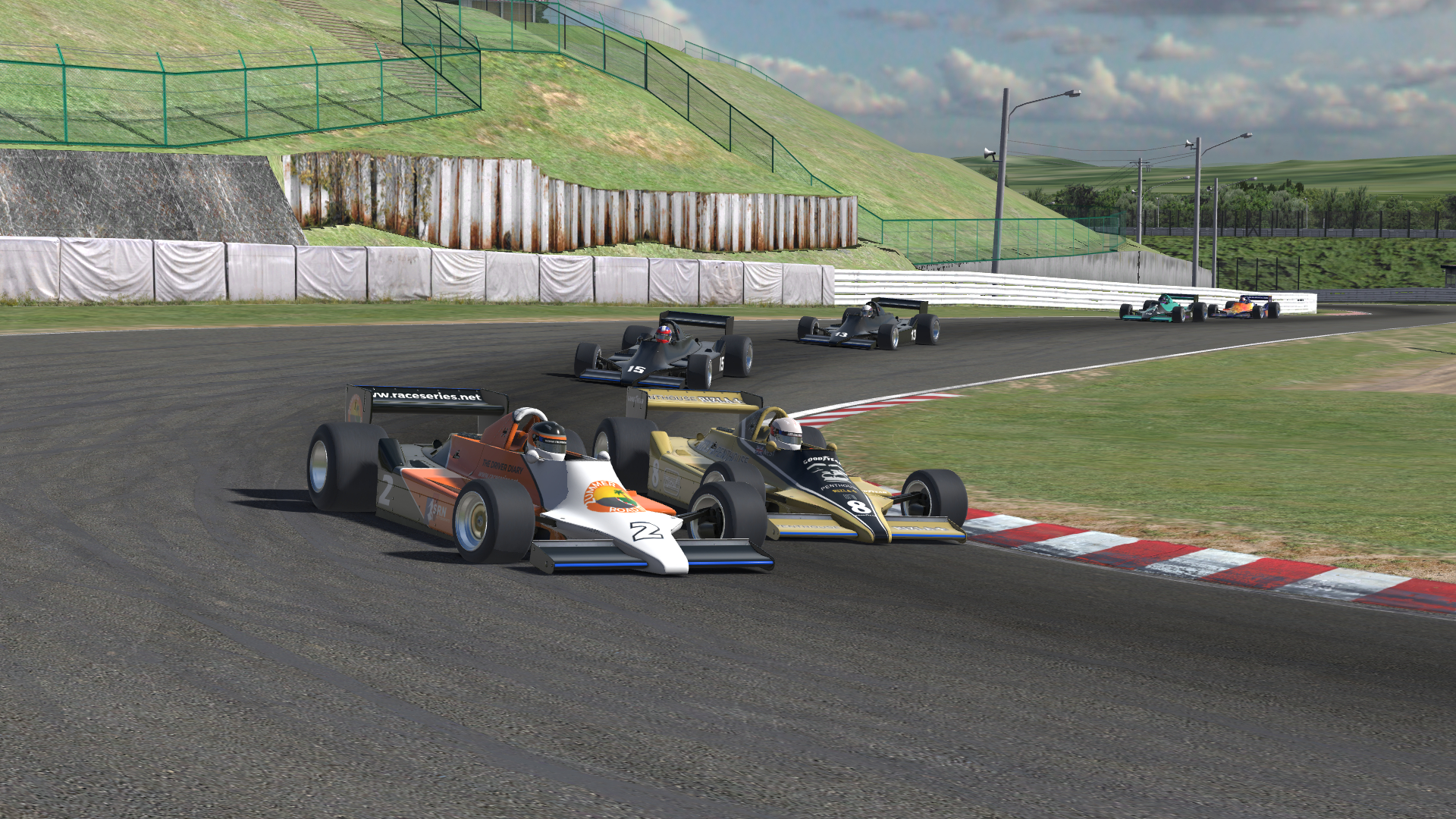
Running side-by-side into the hairpin on lap 1.
I hoped for some attrition ahead, but drivers in this series clearly come prepared to race. Only one driver who started in front of me fell out in the opening laps, and that seemed to be due to connection problems rather than a crash.
Instead, I would have to gain positions the hard way. I had one car in my sights, and I spent the first five laps less than a second behind him. I suspected that he was running more downforce because he seemed to pull away in the esses, but he had one major weak spot that I noted.
Exiting the second of the fast Degner corners, he consistently ran over the raised kerbs, which disrupts the Lotus’s ground effects and can make the car go from an easy rider to a bucking bronco in a split second.
While I envisioned how I might take advantage of one of his mistakes through this corner, I found the gap to him suddenly increasing. A few sloppy laps of my own, plus an awkward encounter with a lapped car in the final chicane, suddenly put me two seconds behind.
But my attempt to close the gap was about to receive an assist from a familiar source several more seconds up the road.
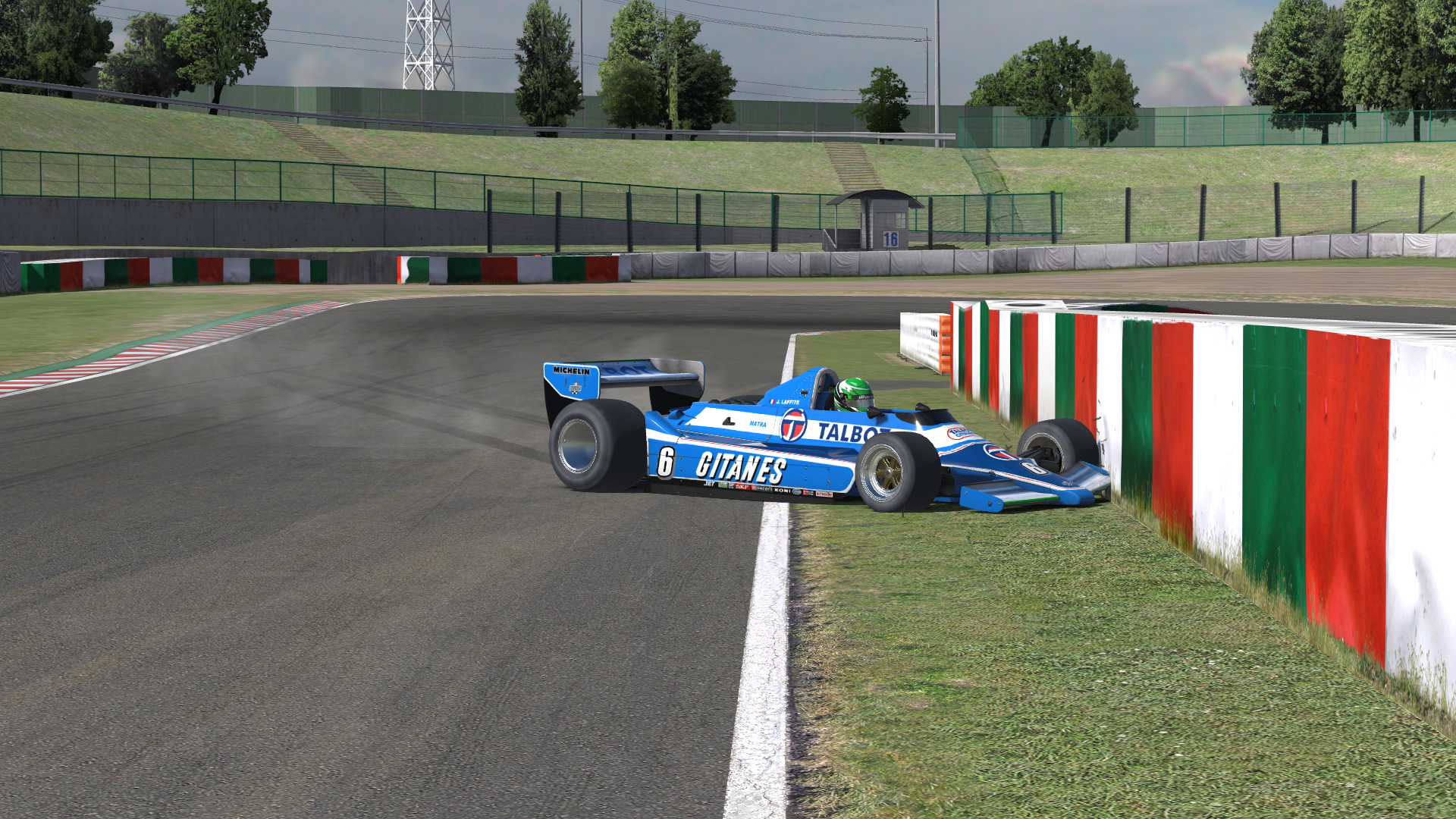
Karl makes a mistake.
Back in the Battle
For most of the race, Karl had been at least a half-second per lap quicker than me, running mostly in the low- to mid-1:49s while I was stuck around a 1:50 flat. But on lap 18, he faced a flash of the widely feared Lotus from its early days on iRacing.
As he put the power down exiting the hairpin, the car broke traction and jogged toward the tire barrier on the left. He nosed in, bending one side of the front wing. After he backed up and got up to speed again – a sign of how far ahead he was before hitting the wall — he rejoined just ahead of the car that had separated the two of us all race.
The wing damage was clearly hurting his pace, and while he could hold his position, I was able to close in on the two cars ahead of me, led by Karl and his banged-up Matra-themed Lotus.
On lap 20, the car between us made a mistake, and it happened in the exact corner I’d pinpointed as his biggest weakness all race. However, it was an odd incident without a clear cause. He hadn’t run across any of the kerbs in the Degner complex, and his car didn’t seem to snap loose as Karl’s had done. Instead, he simply drove straight on through the corner as if he’d had a brake failure.
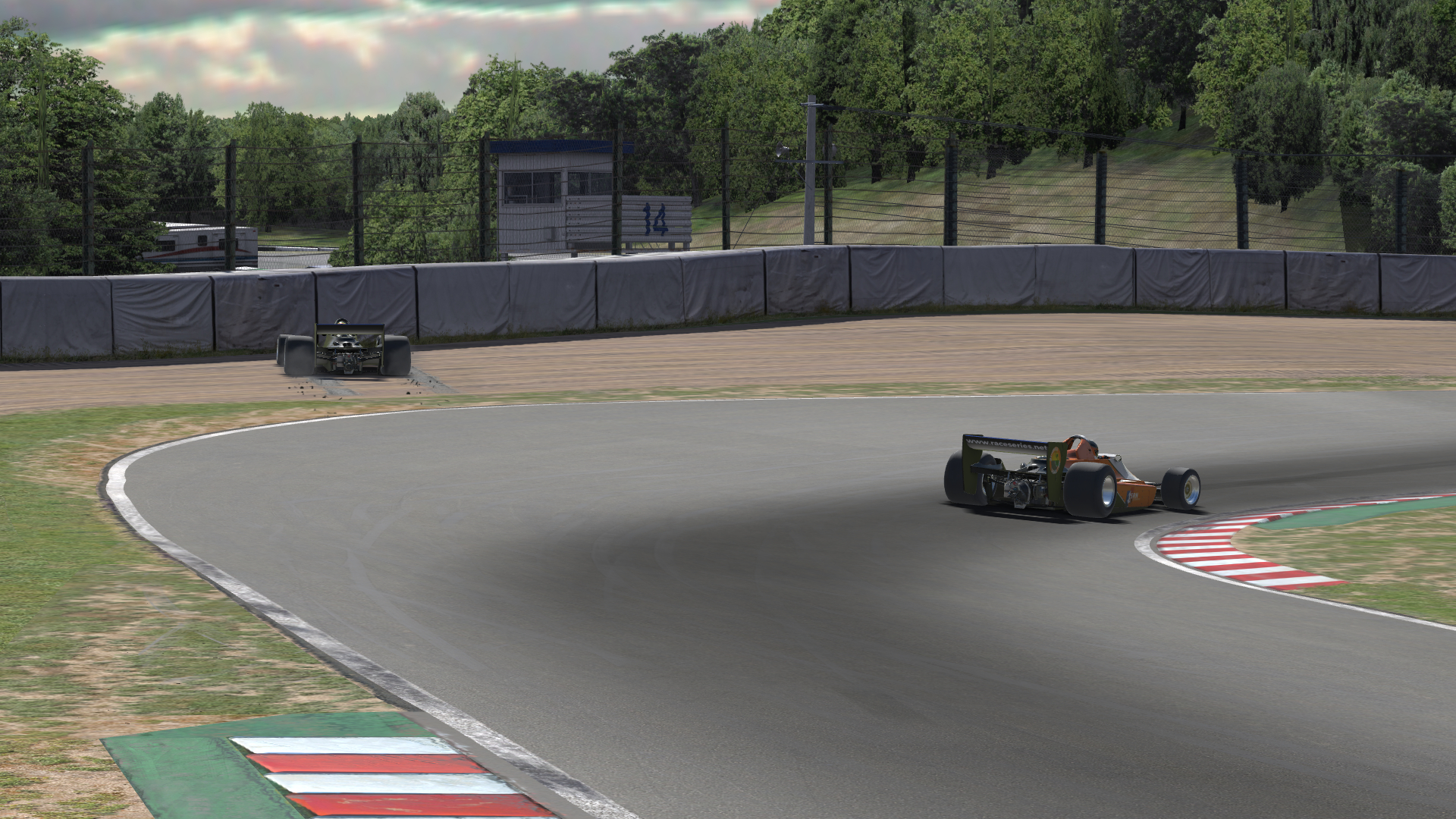
Gaining a position as the car ahead runs off track.
With less than four laps to go, I wasn’t about to ask questions. Instead, I had my sights set on a new target, and his name was Karl.
On the following lap, he made a mistake entering the esses, running onto the grass and allowing me close in even more. While my car seemed to struggle with a bit of aero push through the medium- and high-speed corners, I could catch him down the straightaways and in the final chicane.
Entering the last lap, I was just half a second behind him and pushing as hard as I had all day. Down the backstretch, I wasn’t close enough to make a pass attempt, so in the chicane, I used all of the kerbs, ground effects be damned.
It still wasn’t enough, so in the end, he came away with a fifth-place finish just four tenths of a second ahead of me. As every racer who’s ever come up a little short has said, just one more lap and I would’ve had him.
Classic Lotus Grand Prix - Race
Saturday, August 18 at 10:30 am EDT • Strength of Field: 2509
Finish Start Interval Laps Led Fastest Lap Incidents Points iRating Safety Rating
6 8 -47.838 sec. 0 1:49.578 4 109 5162 (-8) A 4.87 (-0.05)
Series Status
After the race, one of the top finishers shared his setup – a unique and not entirely unexpected gesture in this series’ close community – and after inspecting it, I noticed he was running several degrees higher wing than Karl and I had been. Our suspicion, it seemed, was correct, and more downforce may have been the way to go.
Maybe it was from my curiosity to confirm that, or perhaps I was drawn in again by the fun of the driving the car, but later on Saturday afternoon, I ran some more practice laps and noticed a clear improvement in my pace regardless of which setup I used.
The higher-downforce setup was indeed a few tenths quicker than our race-used one, but in both, I was lapping a half-second quicker than my race pace in the same weather conditions. I credit that to increased confidence after completing a full race distance and taking a less conservative approach through the same corners – the First Turn and Spoon – that costed me so much time earlier in the week.
Ultimately, that knowledge that the driver (rather than the car) is the biggest limiting factor in the Lotus 79 made me want to keep driving it this week, and I suspect that’s true for the solid group of a couple dozen series regulars as well.
Karl, who has run in the Lotus 49 and 79 series off and on over the years, said both cars offer a welcome change from the likes of GT machinery, which he said “are about driving as clinically as possible”.
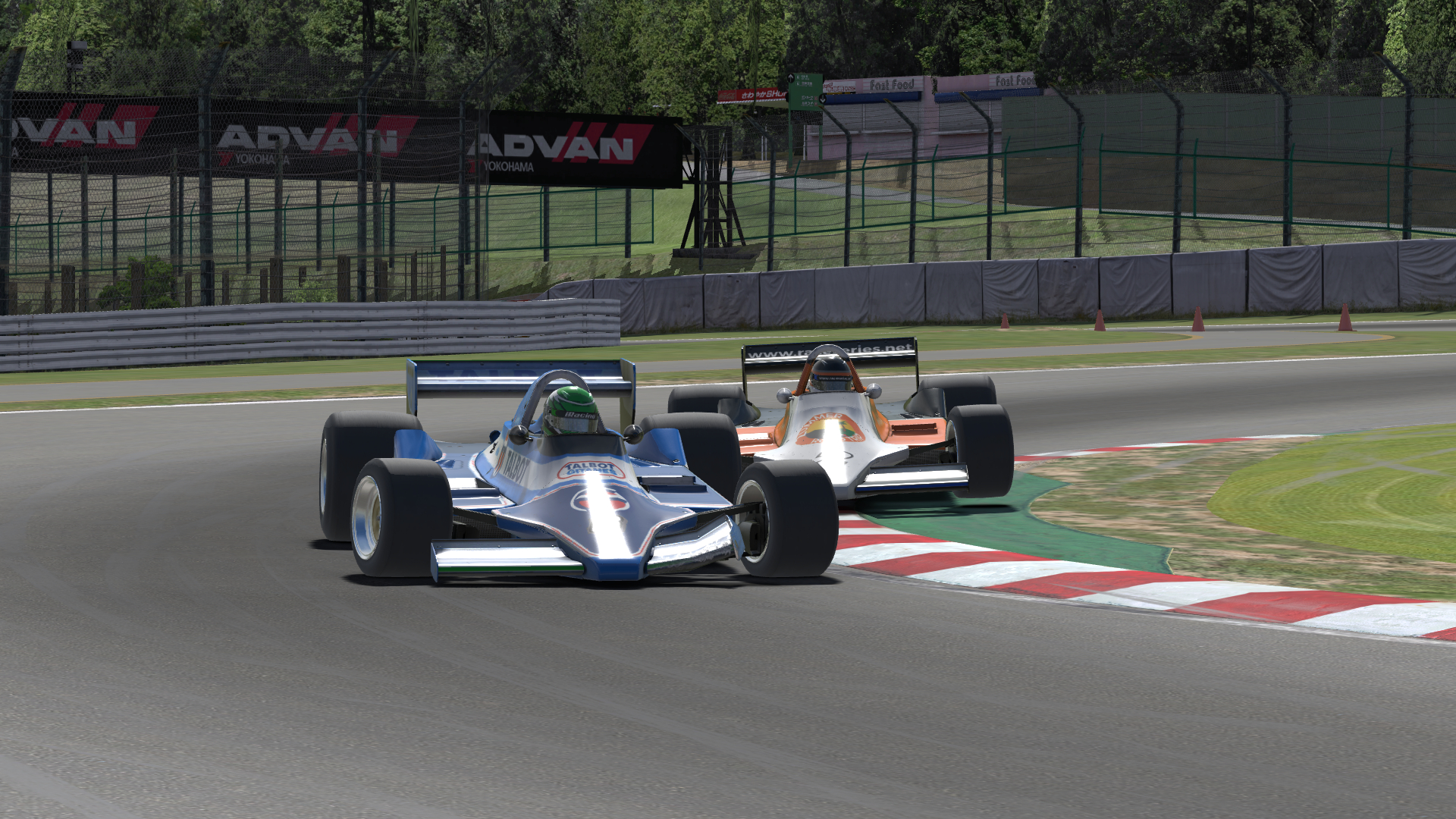
Climbing the kerb in pursuit of Karl.
Instead, these historical open-wheelers “are pretty much impossible to drive in any sort of ‘exact’ way,” he told me, “which takes a lot more effort and makes every corner a bit of a challenge.” Maybe the current Lotus 79 isn’t as wild as its first iteration on iRacing, but it’s now unpredictable in a more fun and predictable sort of way.
Armed with a bit of extra bravery and a faster setup, I was fully prepared to tackle another race on Sunday, this time in the later, broadcasted time slot. Unfortunately, elements outside of sim racing decided against that, and a Saturday night thunderstorm knocked out my Internet service through the day on Sunday.
Like the driver whose car drove straight ahead without warning, my chances of racing again in the Lotus had suddenly, inexplicably hit a wall.
That doesn’t mean I wouldn’t jump at the chance to race this car again, especially at a demanding track such as Suzuka. While the circuit didn’t join the Formula 1 calendar until several years after the Lotus 79’s era ended, the two seem like a perfect fit as they both challenge the traditional notions of what a race car should be able to do.
And with Ronnie Peterson as Karl’s homeland racing spirit guide and Mario Andretti as mine, both of us seem to have a reason to return to the Lotus.
In all of his wisdom, Colin Chapman probably never imagined that his creations would ever be tested in a virtual environment where drivers thousands of miles apart could simultaneously race against each other. But it should surprise no one that his cars are up to the challenge.